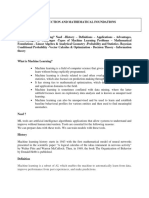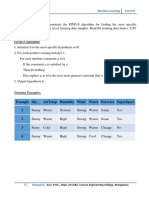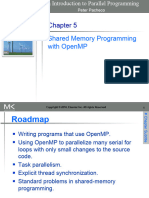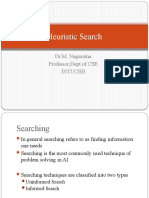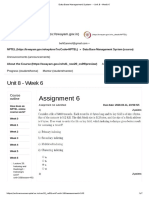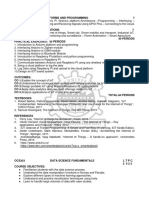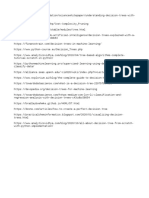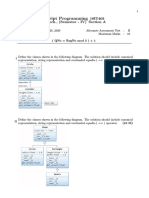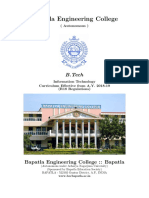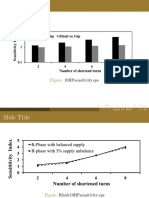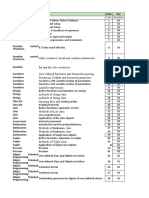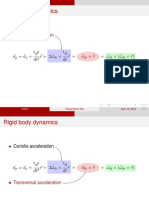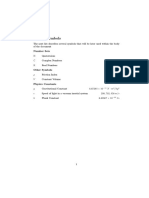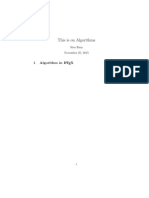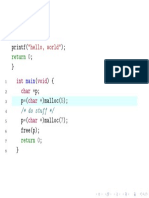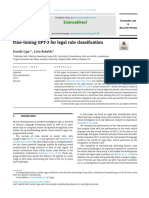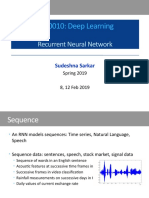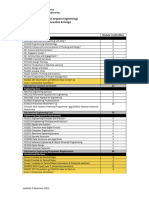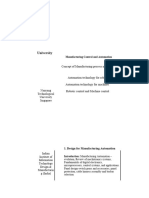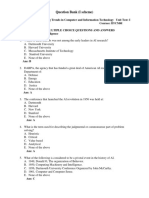T-L1
BAPATLA ENGINEERING COLLEGE
COURSE PLAN
1. Department: Information Technology
2. Program: B.Tech
3. Semester / Year : V Semester / III Year
4. Course title / code : Machine Learning / 18IT505
5. Prerequisite – Code and Title :
NIL
6. Number of Lecture hours / week : 3
7. Date of Preparation : 08/08/2020
8. Syllabus
UNIT - I
(11 Hours)
Machine Learning Basics: Key Machine Learning Terminology - Definitions of Machine
Learning, Task, Performance measure and Experience. Components of Learning. Perceptron
Learning Algorithm. Linear Separability. Types of Machine Learning and Applications of
Machine Learning.
Common loss functions in Machine Learning: Regression losses and Classification
losses.
Optimization of Model Parameters: Batch Gradient Descent, Stochastic Gradient
Descent and Mini Batch Gradient Descent.
Main Challenges of Machine Learning: Capacity, Overfitting, Underfitting and Bias
Variance tradeoff
Regression Models: Linear Regression, Polynomial Regression, Learning Curves,
Regularized Linear Models and Logistic Regression.
UNIT - II
(11 Hours)
Support Vector Machines: Linear SVM Classification, Nonlinear SVM Classification,
SVM Regression.
Decision Trees: Training and Visualizing a Decision Tree, Making Predictions,
Estimating Class Probabilities, The CART Training Algorithm, Gini Impurity or Entropy?,
Regularization, Hyperparameters.
UNIT - III
(11 Hours)
Ensemble Learning: Voting Classifiers, Bagging and Pasting, Out-of-Bag Evaluation,
Random Patches and Random Subspaces, Random Forests, Boosting and Stacking.
Unsupervised Learning Techniques: Partition methods for Clustering: K-Means
algorithm.
1
UNIT - IV
(11 Hours)
Introduction to Artificial Neural Networks: Biological Neurons, Logical
Computations with Neurons, The Perceptron, The Multilayer Perceptron and
Backpropagation and Fine-Tuning Neural Network Hyperparameters.
9. Course Objectives
COB 1: Understand the learning phenomena in living beings.
COB 2: Build a classifier using Regression and Decision Trees.
COB 3: Combine the outcomes of different classifiers for better classification performance.
COB 4: Understand Cluster Analysis.
10. Learning Outcomes Students will be able to:
1.1 Write scripts with basic python constructs and using control flow.
1.2 Identify the usage of functions and write scripts using functions.
2.1 Write scripts that can work on files and directories.
2.2 Use different data structures like tuples, lists and dictionaries.
3.1 Write scripts for performing searching using Regular expressions.
3.2 Write scripts with object oriented concepts like inheritance and encapsulation.
4.1 Handle exceptions while writing scripts using exception handling techniques in python.
4.2 Create python applications that can connect with database and perform CRUD
operations.
11. Teaching – Learning Methods
Online teaching ( M1 )
Demonstration in Anaconda Python Distribution ( M2 )
12. Assessment Methods
Home Assignment ( HA )
Surprise Tests ( ST )
Mid Term Examinations ( MTE )
13. Lesson Plan
2
No. of Learning Teaching Assessment
Week Unit / module / Topic(s)
Hours Outcomes Methods Methods
M1, M2 HA, ST &
1 3 1.1 Machine Learning Basics
& M3 MTE
Common loss functions
in Machine Learning and M1, M2 HA, ST &
2 3 1.2
Optimization of Model & M3 MTE
Parameters
Main Challenges of Machine M1, M2 HA, ST &
3 3 2.1
Learning and Revision & M3 MTE
M1, M2 HA, ST &
4 3 2.2 Regression Models
& M3 MTE
M1, M2 HA, ST &
5 3 2.2 Support Vector Machines
& M3 MTE
M1, M2 HA, ST &
6 3 3.1 Decision Trees
& M3 MTE
M1, M2 HA, ST &
7 3 3.2 Ensemble Learning
& M3 MTE
Unsupervised Learning M1, M2 HA, ST &
8 3 4.1
Techniques & M3 MTE
Introduction to Artificial Neural M1, M2 HA, ST &
9 3 4.2
Networks & M3 MTE
14. Resources
[1] S. Raschka and V. Mirjalili, Python Machine Learning, 2nd ed. Packt Publishing, 2017.
[2] Y. S. Abu-Mostafa, M. Magdon-Ismail, and H.-T. Lin, Learning From Data A short course.
AML publishers, 2012.
[3] T. M. Mitchell, Machine Learning, 1st ed. McGraw Hill Education, 2012.
[4] A. Geron, Hands-On Machine Learning with Scikit-Learn, Keras, and TensorFlow, 2nd ed.
O’Reilly publishers, 2019.
